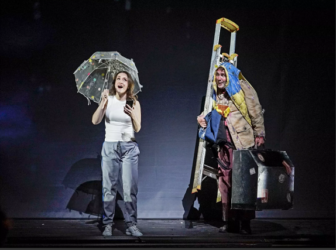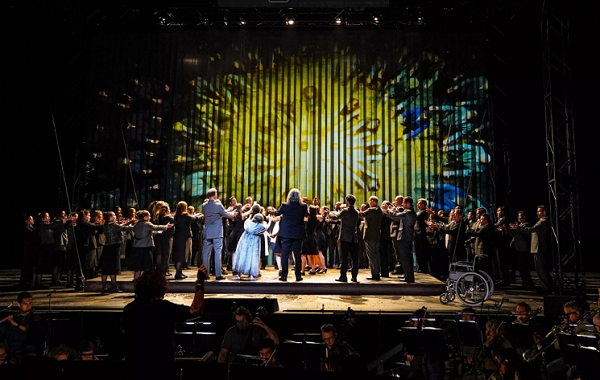 United States The Met: Live in HD – Mozart, Die Zauberflöte: Soloists, Chorus and Orchestra of the Metropolitan Opera House, New York / Nathalie Stutzmann (conductor). Broadcast Live in HD (directed by Gary Halvorson) from the Metropolitan Opera House to Cineworld Basildon, Essex, 3.6.2023. (JPr)
United States The Met: Live in HD – Mozart, Die Zauberflöte: Soloists, Chorus and Orchestra of the Metropolitan Opera House, New York / Nathalie Stutzmann (conductor). Broadcast Live in HD (directed by Gary Halvorson) from the Metropolitan Opera House to Cineworld Basildon, Essex, 3.6.2023. (JPr)

Production:
Production and Choreography – Simon McBurney
Set designer – Michael Levine
Costume designer – Nicky Gillibrand
Lighting designer – Jean Kalman
Projection designer – Finn Ross
Sound designer – Gareth Fry
Associate director – Rachael Hewer
Cast:
Pamina – Erin Morley
Tamino – Lawrence Brownlee
Queen of the Night – Kathryn Lewek
Sarastro – Stephen Milling
Papageno – Thomas Oliemans
Papagena – Ashley Emerson
Monostatos – Brenton Ryan
Speaker – Harold Wilson
First Lady – Alexandria Shiner
Second Lady – Olivia Vote
Third Lady – Tamara Mumford
Genies – Deven Agge, Julian Knopf, Luka Zylik
Priests and Armed Men – Richard Bernstein, Errin Duane Brooks
Foley Artist – Ruth Sullivan
Visual Artist – Blake Habermann
Flute Solo – Seth Morris
Glockenspiel Solo – Bryan Wagorn
The Met: Live in HD Host – Ben Bliss
The two-act 1791 Singspiel Die Zauberflöte (The Magic Flute) was the culmination of Mozart’s increasing involvement with Emanuel Schikaneder’s theatrical troupe which since 1789 had been the resident company at the Freihaustheater auf der Wieden in Vienna. Mozart was a close friend of one of the singer-composers in the troupe, Benedikt Schack (the first Tamino), and had contributed to their compositions, which were often collaboratively written. A year earlier in 1790 Mozart was involved in Schikaneder’s collaborative opera Der Stein der Weisen (‘The Philosopher’s Stone’), contributing the duet (‘Nun liebes Weibchen’ K592a) and perhaps other passages. Like Zauberflöte, that was also a fairy-tale opera and something of its precursor because it had much the same cast in similar roles.
Zauberflöte is noted for its prominent Masonic elements; both Schikaneder and Mozart were Masons and lodge brothers. The opera depicts the triumph of reason over despotism and is also influenced by Enlightenment philosophy and can be regarded as an allegory propounding enlightened absolutism (the unrestrained power of a minority over the majority). The Queen of the Night is the dangerous form of obscurantism (opposition to the increase and spread of knowledge), whilst her antagonist Sarastro is the reasonable sovereign who rules with paternalistic wisdom and enlightened insight.
The original libretto of Zauberflöte also contains a racial stereotype in the form of Monostatos (who we are to understand makes his unwelcome advances to Pamina because he is a Moor and black) and equally dreadful misogyny (all women are subservient to men). Oddly, in recent years all references to Monostatos’s colour has been expunged whilst misogyny is apparently not as bad as racism and lines – as noted from a previous translation – such as ‘Without a man a woman cannot fulfil her destiny’, ‘First duty of Brotherhood is to be aware of the wiles of woman’ and ‘Our sanctuary has been profaned … send these women to hell’ seem to have been retained.
This little bit of background should not obscure the fact that Simon McBurney’s magnificent production – which reached The Met nearly 11 years after it was first put on in Amsterdam – made this Zauberflöte one of the most entertaining operas I have ever seen making me very sorry I had not gone to it in the intervening years when revived by English National Opera. McBurney is founder and artistic director of the Théâtre de Complicité and his stated intention was to recreate something of the frisson of the opera’s first-ever performance by putting some of the artifice of a theatrical event in full view of the audience and incorporating it into what is seen and heard. On one side of the stage is the Foley Artist Ruth Sullivan’s box of tricks enabling her to create an eclectic range of sound effects from often very mundane things. (Be honest who won’t laugh-out-loud when Papageno completes the tuning of his bottle xylophone by apparently reliving himself into one of them.) Over on the other side Visual Artist Blake Habermann has a board on which he chalks – among much else – titles, key words, a hint of mountains (also allowing for some shadow play), and lots of arrows, all of which will be projected onto the stage. Fin Ross’s video is also used to good effect from the giant snake at the beginning to the flames flickering across the stage during the Act II trials when (the flying) Tamino and Pamina will also look as if they are submerged in water. Earlier Sarastro’s temple is shown by an image of several books with a couple drawing back before barring Tamino from entering.
Otherwise, dominating the stage is set designer Michael Levine’s large platform which goes up, down or over to add atmosphere to different scenes allowing characters to clamber onto it, slide around on it, allow for furtive behaviour below it and can even be transformed into a huge table for the gathering of the priests at the start of Act II. McBurney turns this into a Masonic lodge meeting, with the Freemasons wearing grey suits (costume designer Nicky Gillibrand’s overall colour palette is rather muted and monochrome). The informally dressed members of the orchestra are raised to the lip of the stage and, along with conductor Nathalie Stutzmann, play a part in the production and frequently encounter the characters passing amongst them. Principal flautist Seth Morris moves up from the pit to play the magic flute itself, whilst Papageno’s magic bells sound out from a portable celeste on the edge of the stage which needs Bryan Wagorn to play it except near the end of Act II when he is AWOL on a coffee break (!) and the very versatile Thomas Oliemans (Papageno) must play them for himself.
It is all brilliantly inventive as we watch the forces of darkness and light confront each other, and my few words can only give the vaguest impression of what goes on. If you were like me and have not yet seen this ground-breaking Zauberflöte then I urge you to go to it if there is a chance. There was not a weak link in the cast, yes, it is possible to want more chemistry between Tamino and Pamina; Lawrence Brownlee has a cultured tenor voice and was a more introspective prince than sometimes seen, whilst Erin Morley was a delightful Pamina and projected her role as well as anyone in the cast and sang an achingly ardent ‘Ach, ich fühl’s’. The Three Ladies (Alexandria Shine, Olivia Vote, Tamara Mumford) were vocally distinctive and acted rather like sex-mad Valkyries claiming Tamino for Valhalla. There were two notably well-sung vignettes from Harold Wilson as a jobsworth Speaker of the Temple and Brenton Ryan as the predatory and sleazy Monostatos.

In her 50th Queen of the Night at the Met Kathryn Lewek approached the fearsome role with consummate coloratura ease and just about nailed her top Fs. McBurney shows how her evilness has sucked the life out of her and has her confined to a wheelchair but at the end she regains her youth when reconciled with Sarastro. I first saw Stephen Milling sing his more-than-usually avuncular Sarastro in 2008 and all these years later he again used his astonishing bass voice to cavernous effect. Catching both eye and ear in her short time onstage was Ashley Emerson as a perky Papagena. The three child-spirits are ‘boys’ no more and called ‘Genies’ who hobble around held up by their walking sticks whilst singing charmingly.
Most of the vocal honours go to Thomas Oliemans as the stepladder-clutching bird-catcher Papageno who is covered in droppings and wears a shabby gilet in Ukrainian blue and yellow. Oliemans’s Papageno searches for a wife through the audience and chalks up a mobile number when he spots someone he likes the look of and he also generated an earworm by playing a few notes on his pipes which after a while coalesced in my brain as the opening of ‘New York, New York’! His acting was of the highest standard – and a great example of McBurney’s Personregie – although his dark, burnished baritone took a little time to warm up.
The Met’s chorus made their usual incisive contribution and were supported by actors frequently fluttering – what looked like – pages from the score as birds. French conductor Nathalie Stutzmann led a very vibrant and fleet-footed musical performance that didn’t sound as if it sought any new revelations while jollying things along so that – despite all the dialogue, as well as the longueurs of the second act – the three hours and more went by quickly and so very enjoyably: too few nights at the opera are like that!
Jim Pritchard
